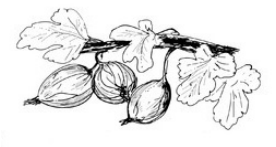Brambles include raspberries, blackberries and recently developed hybrids like tayberries. All have similar cultural and nutrient requirements. Berries are highly perishable and expensive so home plantings are an excellent way to assure a supply of this flavorful fruit.
Brambles tolerate a wide range of soil types but require sites with good drainage. Phytophora root rot may be a problem on poorly drained sites. Ideal soils will be moderately fertile, well draining, slightly acidic and contain 4 to 8 percent organic matter.

As the amount of organic matter in a soil increases so will its capacity to hold water. For maximum size and harvest, brambles should be provided with at least two inches of water per week during fruit swell and harvest. Increasing the soil’s ability to hold water, and use of a mulch are especially important if rainfall or irrigation is limited through this period of development.
Brambles are susceptible to potassium deficiencies and this can result in soft, poorly formed fruit. A common material for increasing soil potassium levels is potassium chloride (KCl). Since brambles exhibit a sensitivity to chlorine, it may be advisable to use potassium sulfate (K2SO4) or sul-po-mag (0-0-22).
Currants and gooseberries are woody perennial shrubs belonging to the genus Ribes. Their popularity has diminished somewhat over the years but many still treasure the tart berries for jellies, pies and syrups. Plants are very hardy, self-fruitful and tolerate a partially shaded site. They prefer cool, moist growing conditions and a well-drained soil rich in organic matter.
Six months to one year before planting:
Build up the organic matter by incorporating well-rotted manure, compost, peat moss or other organic materials. An organic matter content of between 4 and 8% would be suitable for brambles, currants and gooseberries. Keep in mind that manures and composts contain nutrients as well as organic matter. Add ½ inch to one inch of one of these materials to your planting bed and mix it into the top 6 inches of soil. Test the soil about a month later to see if any additional nutrients are needed.
Brambles, currants and gooseberries all prefer a slightly acidic soil with a pH ranging from 6.0 to 6.8. Apply the amount of ground limestone recommended on the soil test report if it is necessary to adjust the soil pH. It is generally advisable to use a dolomitic limestone that contains both calcium and magnesium, especially if the soil has below optimum magnesium levels. If soil test magnesium levels are above optimum, a calcitic limestone can be substituted.
If soil test results for potassium are below optimum, apply potassium sulfate (0-0-50) at a rate of ¾ lbs. (1½ cups), or sul-po-mag (0-0-22) at a rate of 11/2 lbs. (2 cups), per 100 sq. ft. If soil test results for phosphorus are below optimum, apply superphosphate (0-20-0) at the rate of 1¼ lbs. (2½ cups), triple superphosphate (0-46-0) at the rate of ½ lbs. (1 cup), or bonemeal (1-11-0) at the rate of 2 lbs. (6 cups) per 100 sq. ft. Incorporate all necessary amendments thoroughly to a depth of 6 to 8 inches.
Without a soil test:
First Year of Planting:
Without a soil test, apply ½ ounce (1 tbsp.) 10-10-10 (or equivalent) in an area 18 inches in diameter after plants begin growing. Repeat the application 4 to 6 weeks later. Water liberally after each fertilizer application.
Second Year After Planting:
In early April, fertilize brambles by applying 3 ounces (6 tbsp.) of 10-10-10 (or equivalent) per 10 feet of row in a strip two feet wide centered on the plant row. Repeat this same rate 4 to 6 weeks later. For individual currant or gooseberry plants, use 1 ounce (2 tbsp.) 10-10-10 (or equivalent) per plant in an area 2 ft. by 2 ft. in each of the two applications.
Third Year and Older:
Fertilize brambles by applying 6 ounces (3/4 cup) of 10-10- 10 (or equivalent) per 10 feet of row in early April. Use half on each side of the row. Keep fertilizer granules at least 6 inches away from plant stems. Avoid fertilizers that contain chlorides. Repeat the same rate 4 to 6 weeks later. For individual currant or gooseberry plants, use 2 to 3 ounces (¼ to 1/3 cup) of 10-10-10 (or equivalent) per plant in each of the two applications
NOTE:
10 lbs of 10-10-10 will supply plants with 1 lb. of Nitrogen (N), 1 lb. of Phosphate (P2O5) and 1 lb of Potash (K2O) per 1000 sq. ft. (Phosphate is a form of phosphorus; Potash is a form of potassium)
10 lbs of 5-10-10 will supply plants with 1/2 lb. of Nitrogen (N), 1 lb. of Phosphate (P2O5) and 1 lb. of Potash (K2O) per 1000 sq. ft. 10 lbs. of 5-10-5 will supply plants with ½ lb. of Nitrogen (N), 1 lb. of Phosphate (P2O5) and 1/2 lb. of Potash (K2O) per 1000 sq. ft.
To supply nutrients using natural/organic sources use the following equivalents:
1 lb. of Nitrogen can be supplied by 8.3 lbs. of bloodmeal (12-0-0) or 11 lbs. of corn gluten (9-0-0).
1 lb. of Phosphate can be supplied by 6.75 lbs. of bonemeal (3-15-0) or 33.5 lbs. of rock phosphate (0-3-0).
1 lb. of Potash can be supplied by 25 lbs. of kelp meal (1-0-4) or 4.5 lbs. of sul-po-mag (0-0-22)* or 2 lbs. of potassium sulfate (0-0-50)**.
Keep in mind that the NPK analysis of natural organic products may vary by producer and adjust your application rates accordingly.
*Note: May need to be special or mail ordered.
**Note: Not all sources are certified for organic production
By Dawn Pettinelli, Associate Extension Educator, PSLA. Written 2001, Revised 2015, 2023.
Questions? Contact:
UConn Soil Nutrient Analysis Laboratory
Department of Plant Science and Landscape Architecture
Phone: 860.486.4274
Email: soiltest@uconn.edu
Website: soiltesting.cahnr.uconn.edu
UConn is an equal opportunity program provider and employer.
©UConn Extension. All rights reserved.